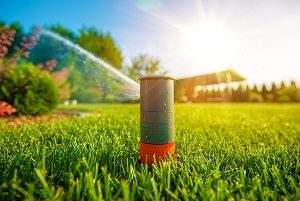 There are many options to choose from when it comes to irrigation for your home or business, and it is a vital part of maintaining great lawns and plantings. From soaker hose and drip irrigation lines to keep gardens and other plants watered in the most efficient way, to sprinkler/spray systems, all the way to industrial-strength rotor systems for large estates or commercial lawns. Today we’ll look at the most commonly installed system: the lawn sprinkler system, and see how they work and why they are a good fit for most irrigation needs.
There are many options to choose from when it comes to irrigation for your home or business, and it is a vital part of maintaining great lawns and plantings. From soaker hose and drip irrigation lines to keep gardens and other plants watered in the most efficient way, to sprinkler/spray systems, all the way to industrial-strength rotor systems for large estates or commercial lawns. Today we’ll look at the most commonly installed system: the lawn sprinkler system, and see how they work and why they are a good fit for most irrigation needs.
Lawn Sprinkler Systems: The Basics
A sprinkler system is a laborious install, but is fundamentally a pretty simple system consisting of four parts that deliver water across your various areas (called zones) of your property:
- The Controller: The controller is the electrical system that turns the sprinklers on and off, also sometimes known as the timer. Advanced systems are also hooked up to rain sensors to avoid overwatering.
- The Control Valve Box: This box is hooked up to the controller and does the heavy lifting as a connection point between the water supply and the various zones of the waterlines. These are also connected to a backflow device.
- Underground Waterline: These pipes are the time-intensive part of this irrigation installation, feeding the water from the source to the strategically places sprinkler heads. Waterlines are arranged in zones for each line.
- Sprinkler Heads: The actual delivery device, these heads are pushed out of their recesses in the ground by water pressure and operated mechanically on water pressure, rotated in small or large arcs to properly cover the lawn and gardens of your business or home.
This lawn sprinkler system is perfect for most small-to-medium homes and businesses, but it should be installed by professionals. Dolan Landscaping has been installing irrigation systems for over 25 years: contact us today for a consultation on your irrigation needs for your home or business.